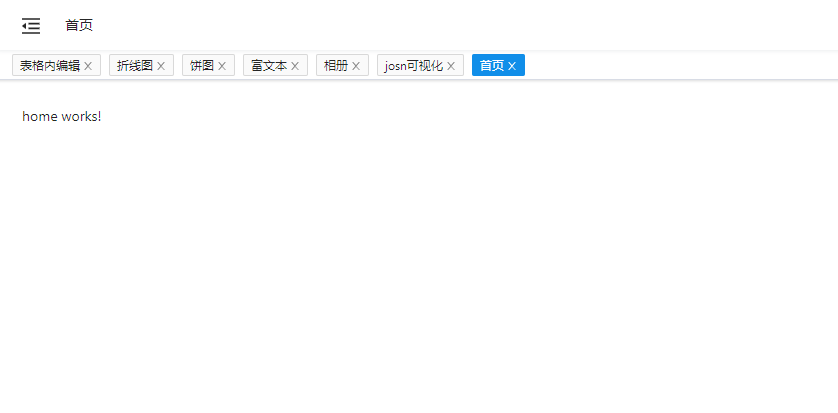# 布局
页面布局是一个产品最外层的框架结构,往往会包含导航、侧边栏、面包屑以及内容等。
# Layout
位置
src/@Layout
项目目前提供2种lauout布局方案,后续会新增多种布局形式。
ng-zorro-admin 中 main/pages 页面都是基于这个 layout 的,除了个别页面如:login , 404, 等页面没有使用该layout。如果你想在一个项目中有多种不同的layout,只要在一级路由那里选择不同的layout组件就行。
import { LayoutTopSideComponent } from '@layout/layout-top-side/layout-top-side.component';
import { MainLayoutDefaultComponent } from '@layout/main-layout-default/main-layout-default.component';
const routes: Routes = [
{
path: '',
// 你可以选择不同的layout组件
component: LayoutTopSideComponent,
// 这里开始对应的路由都会显示在 <router-outlet></router-outlet> 中
children: [
{
path: 'home',
component: HomeComponent,
data: {
title: '首页',
}
}]
}]
这里使用了 路由嵌套 , 所以一般情况下,你增加或者修改页面只会影响 <router-outlet></router-outlet> 这个主体区域。其它配置在 layout 中的内容如:侧边栏或者导航栏都是不会随着你主体页面变化而变化的。
/foo /bar
+------------------+ +-----------------+
| layout | | layout |
| +--------------+ | | +-------------+ |
| | foo.component | | +------------> | | bar.component | |
| | | | | | | |
| +--------------+ | | +-------------+ |
+------------------+ +-----------------+
当然你也可以一个项目里面使用多个不同的 layout,只要在你想作用的路由父级上引用它就可以了。
# 侧边栏
本项目侧边栏主要基于 ng-zorro 的 ng-menu 改造。
侧边栏是根据菜单目录生成的,开发时候我们需要手写菜单目录,为了多套布局共用将其单独提成文件,位置在 @layout/menu-list.ts , 结构为一个json数组如图
export const menuList = [
{
id: 1,
name: '首页',
ico: 'dashboard',
link:'/web/home',
children: []
},{
id: 2,
name: '图表',
ico: 'bar-chart',
nzIconfont:'icon--yiliao-jiyin',
children: [
{
id: 21,
name:'折线图',
link: '/web/echarts/line',
},
{
id: 22,
name:'饼图',
link: '/web/echarts/pie',
}
]
}]
- id: 唯一值
- name: 菜单名称
- ico: NG-ZORRO的icon图标
- nzIconfont: 支持阿里图标,优先级大于ico
- link: 路径
注意:若没有children 请设置为空数组,不要省略。针对有无子集和使用了何种图标的情况做了自动处理,渲染代码如下:
<ul nz-menu nzMode="inline" class="sider-menu scrollbar" >
<ng-container *ngFor="let item of menuList">
<ng-container *ngIf="item.children.length!=0">
<li nz-submenu *ngIf="!item.nzIconfont" [nzTitle]="item.name" [nzIcon]="item.ico">
<ul>
<li *ngFor="let it of item.children" [routerLink]="it.link" nz-menu-item nzMatchRouter>{{it.name}}</li>
</ul>
</li>
<li nz-submenu *ngIf="item.nzIconfont" [nzTitle]="titleTpl">
<ng-template #titleTpl> <i nz-icon [nzIconfont]="item.nzIconfont"></i><span>{{item.name}}</span></ng-template>
<ul>
<li *ngFor="let it of item.children" [routerLink]="it.link" nz-menu-item nzMatchRouter>{{it.name}}</li>
</ul>
</li>
</ng-container>
<ng-container *ngIf="item.children.length==0">
<li nz-menu-item *ngIf="!item.nzIconfont" [routerLink]="item.link" nzMatchRouter>
<i nz-icon [nzType]="item.ico"></i>
<span>{{item.name}}</span>
</li>
<li nz-menu-item *ngIf="item.nzIconfont" [routerLink]="item.link" nzMatchRouter>
<i nz-icon [nzIconfont]="item.nzIconfont"></i><span>{{item.name}}</span>
</li>
</ng-container>
</ng-container>
</ul>
注意
如果要设置菜单默认展开,只需给nz-submenu这层增加 nzOpen属性,但是官方组件样式nz-submenu的DOM默认带 ant-menu-submenu-active类目,导致子属性未选中,但是父级有状态色的bug,目前官方还未解决这个bug:https://github.com/NG-ZORRO/ng-zorro-antd/issues/6542 (opens new window)。
如果遇到这种需求,可以暂时用样式覆写的方式,把ant-menu-submenu-active的样式颜色去掉。
菜单权限
思路是通过 role 去获取当前角色可访问的菜单 tree , 然后 filterMenu 方法过滤 menuList , 拿到可以访问的菜单,具体会在 权限验证 一节中详细说明
# 面包屑
ng-zorro 提供了根据routers自动生成面包屑组件 Breadcrumb (opens new window),但不建议使用他。
<nz-breadcrumb [nzAutoGenerate]="true" [nzRouteLabel]="'title'"></nz-breadcrumb>
因为可能某些页面的面包屑,不按常规规则来,比如tab页,是没办法把对应tab页的title自动生成到面包屑中的,推荐每个模板中单独手写面包屑,会更加灵活。
<div class="bread">
<nz-breadcrumb>
<nz-breadcrumb-item>
<a [routerLink]="['/']">首页</a>
</nz-breadcrumb-item>
<nz-breadcrumb-item>
后台管理
</nz-breadcrumb-item>
</nz-breadcrumb>
</div>
# 快捷导航 (历史页签)
在 MainLayoutDefaultComponent 这个layout布局组件中,引用了 快捷导航 (历史页签) 功能,会在访问页面的时候,自动缓存成快捷导航。如图:

组件 封装在 @lauout/widgets/tag-view,可以直接引用
<app-tag-view></app-tag-view>
目前缓存在sessionStorage,也可以根据需求把缓存写入localStorage实现关闭浏览器页签不消失。
# 全屏
组件 封装在 @lauout/widgets/screnfull,可以直接引用
<app-screenfull></app-screenfull>
# 用户信息

组件 封装在 @lauout/widgets/user,可以直接引用。
<app-user></app-user>
'管理员' 是动态获取的,思路是在 路由守卫 中,从接口请求当前账号的信息,存入一个全局的authObservable属性中,authObservable是一个 BehaviorSubject (opens new window) ,观察者通过订阅,可以拿到最新的值。
// @service/auth.guard.ts
export class AuthGuard implements CanActivate {
constructor(private authSerice: AuthService,private router: Router){}
authObservable = new BehaviorSubject(null);
canActivate(
route: ActivatedRouteSnapshot,
state: RouterStateSnapshot): Observable<boolean> | Promise<boolean> | boolean {
const url = state.url
if (url === '/passport/login') {
return this.authSerice.logoutSystem().pipe(
map(() => true),
catchError(() => of(true))
);
} else {
return this.authSerice.getCurrentAuth().pipe(
map((authReulst: any) => {
if (authReulst) {
//权限数据发布到BehaviorSubject
this.authObservable.next(authReulst);
return true;
}
this.router.navigateByUrl('/passport/login');
return false;
}),
catchError((error) => {
this.router.navigateByUrl('/passport/login');
return of(false);
})
)
return true;
}
}
}
// @layout/widgets/user/user.component.ts
import { Component, OnInit } from '@angular/core';
import { Router } from '@angular/router';
import { AuthService } from '@service/auth.service';
import { AuthGuard } from '@service/auth.guard';
@Component({
selector: 'app-user',
templateUrl: './user.component.html',
styleUrls: ['./user.component.less']
})
export class UserComponent implements OnInit {
currentUser: any;
constructor(private guard:AuthGuard) { }
ngOnInit(): void {
//订阅BehaviorSubject,得到权限数据
this.guard.authObservable.subscribe((res:any)=>{
this.currentUser = res?.name
})
}
}